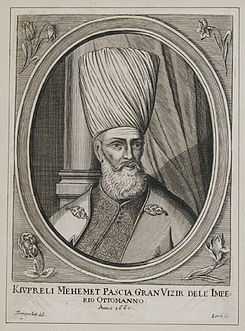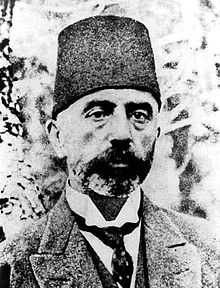Albanians in Turkey
| |||||||||||||
| Total population | |||||||||||||
|---|---|---|---|---|---|---|---|---|---|---|---|---|---|
| 500,000 to 1,300,000 [1][2] | |||||||||||||
| Regions with significant populations | |||||||||||||
| Marmara Region | |||||||||||||
| Languages | |||||||||||||
| Albanian, Turkish, Serbo-croatian | |||||||||||||
| Religion | |||||||||||||
| Islam, Irreligious | |||||||||||||
Albanians in Turkey are ethnic Albanian citizens and denizens of Turkey. A 2008 report from the Turkish National Security Council (MGK) says that approximately 1,3 Million people of Albanian ancestry live in Turkey, and more than 500,000 recognize their ancestry, language and culture. They consist mostly of Kosovar/Macedonian and Tosk Cham Albanians fleeing from Serbian and Greek persecution after the beginning of the Balkan Wars, but also some Albanians from Montenegro and Albania proper.
The Turkish-Albanian Brotherhood Culture and Solidarity Association aims to preserve Albanian culture and traditions by hosting cultural nights and folklore festivals. This organization based in Bayrampaşa (Istanbul) has three branches located in Küçükçekmece and in the provinces of Ankara and Bursa. It also provides Albanian language classes throughout the year and organizes celebrations to commemorate the independence of Albania.
Numbers
In the census of 1965, 12,832 Turkish citizens spoke Albanian as first language, which is only 0.04% of the population. These people were mostly living in Bursa (0.3%), Sakarya (0.2%), Tokat (0.2%) and Istanbul (0.2%). Another 390,613 spoke Albanian as second language.
According a 2011 survey, 0.2% in Turkey, roughly one hundred and fifty thousand people, identify themselves Albanian;[3] while according to one source, Turkey has about five million citizens of full or partial Albanian descent.[1] According to a Milliyet article, there are over 1.3 million Albanians in Turkey. The article says that more than half of these people are Turkified, while some 500 thousands retain their Albanian identity.[2]
Emigration History
Albania was the last nation in southeastern Europe to claim independence from the Ottoman Empire, on 28 November 1912. The first wave of the Albanian diaspora left for Turkey during the Greco-Turkish population exchange of 1923. They have populated the areas of Erenköy and Kartal in Istanbul,[4] as well as a number of towns in the area of Bursa, especially Mudanya.[5] After the Second World War, others settled in Izmir, Gemlik and Aydin.[6]
Many Albanians emigrated to Turkey between 1950 and 1970. In that period, Islam in Yugoslavia was repressed, and both Albanians and Muslim Slavs were encouraged to declare themselves Turkish and emigrate to Turkey. In the 1990s, Turkey received a wave of Kosovan refugees, fleeing from conflict. Today, the number of ethnic Albanians in Turkey is estimated to be between 150,000 and 1,300,000, 500,000 of them still having a strong Albanian identity.[7]
Chams in Turkey
Muslim Chams in Turkey form the second largest community of Chams, after Albania.[8] This community was established after the two World Wars. After the First World War, Chams were forced to leave for Turkey during the population exchange,[4][9][10] and another migration wave followed after the Second World War, when a minority of the Chams expelled from Greece chose Turkey over Albania because of their anti-communist sentiments.[6]
The exact number of Muslim Chams in Turkey is unknown, but various estimates conclude that they number between 80,000 to 100,000,[6] from a total population of 150,000 to 1.3 million Albanians that live in Turkey. The Chameria Human Rights Association declares that most of them have been linguistically assimilated, although they maintain Albanian consciousness and regional Cham traditions.[11] A considerable number of Chams in Turkey have changed their surnames to Cam or Cami, which in Turkish means pine, in order to preserve their origin.[6] They are organized within the "Albanian-Turkish Brotherhood Association" (Albanian: Shoqëria e Vllazërisë Shqiptaro-Turke, Turkish: Türk-Arnavut Kardeşliği Derneği), which fights for the rights of Albanians.[6]
References
- ↑ 1.0 1.1 Christopher Deliso (2007). The Coming Balkan Caliphate: The Threat of Radical Islam to Europe and the West. Greenwood Publishing Group. pp. 38–. ISBN 978-0-275-99525-6. Retrieved 19 September 2012.
- ↑ 2.0 2.1 "Türkiyedeki Kürtlerin Sayısı!" (in Turkish). Milliyet. 2008-06-06. Retrieved 2008-06-07.
- ↑ Genar - Araştırma Danışmanlık Eğitim
- ↑ 4.0 4.1 Fabbe, Kristin (18 October 2007). "Defining Minorities and Identities - Religious Categorization and State-Making Strategies in Greece and Turkey" (PDF). Washington, United States of America: Presentation at: The Graduate Student Pre-Conference in Turkish and Turkic Studies University of Washington. p. 49.
- ↑ Yildirim, Onur (2006). Diplomacy and Displacement: Reconsidering the Turco-Greek Exchange of Populations, 1922-1934. Istanbul, Turkey: CRC Press. p. 121. ISBN 978-0-415-97982-5. 9780415979825. Retrieved 2009-03-31.
- ↑ 6.0 6.1 6.2 6.3 6.4 Berisha, Mal (November 2000). Diaspora Shqiptare në Turqi (in Albanian). New York: ACCL Publishing. p. 13.
- ↑ "Türkiye'deki Kürtlerin sayısı!" (in Turkish). 6 June 2008. Archived from the original on 2010-11-13. Retrieved 8 September 2010.
- ↑ Vickers, Miranda. The Cham Issue - Where to Now? (PDF). Defence Academy of the United Kingdom.
- ↑ Roudometof, Victor (2002). Collective Memory, National Identity, and Ethnic Conflict: Greece, Bulgaria, and the Macedonian question. Westport, Connecticut, United States of America: Greenwood Publishing Group. p. 182. ISBN 978-0-275-97648-4. 9780275976484. Retrieved 2009-03-31.
- ↑ Mai, Nicola; Schwandner-Sievers, Stephanie (2005). Russell, King, ed. The New Albanian Migration. Sussex, UK: Sussex Academic Press. p. 87. ISBN 978-1-903900-78-9. 978-1-903900-78-9. Retrieved 2009-03-31.
- ↑ Bollati, Sali; Vehbi Bajrami (June 2005). "Interview with the head of Chameria organization / Bollati: Chameria today" (in Albanian and English). New York, United States of America. Iliria Newspaper.
| ||||||||||||||||||
| ||||||||||||










